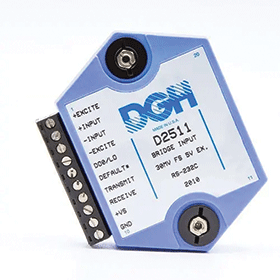

Despite the wide-spread use and varied application opportunities of strain gauge
load cell technology, limited attention has been focused on streamlining the integration of these sensors into existing or new systems. Vepac’s data acquisition hardware provides an efficient and effective all-in-one solution for customers looking to simplify, enhance and optimise their strain gauge load cell systems.
What Is a strain gauge load cell?
Strain gauges are sensors that change their electrical values under strain. A strain gauge consists of resistive elements that are adhered to a substrate. The amount of strain – or force – applied to the substrate will change the electrical resistance of the strain gauge.
Multiple strain gauges can be connected in a resistive bridge configuration to measure strain based on small changes in electrical resistance. This configuration is called a Wheatstone bridge, and is normally positioned inside the load cell housing to convert the strain acting on bridge into electrical signals. To measure strain, these types of load cells must be connected to an electrical device that can supply DC excitation voltage to the bridge circuit. The electrical device must also contain measurement circuitry to accurately measure the small voltage changes from the bridge that correspond to the amount of strain applied.
Measuring a strain gauge load cell
In a Wheatstone bridge configuration, excitation voltage is applied at the top and bottom of the bridge circuit, and the output voltage is measured across two points in the middle of the bridge. When there is no strain applied on the load cell, the Wheatstone bridge is considered balanced and there is zero output voltage. From there, any small strain or flex on the substrate material will cause the strain gauge to change resistance. This will cause the bridge to become unbalanced, resulting in a change in the output voltage.
In many applications, the strain gauge resistance changes are so small that signal amplifiers are required to detect the small amounts of voltage change from the bridge. Signal amplifiers can lead to unwanted noise in the amplified signal, causing unstable or noisy signals. To remove the unwanted noise, signal conditioning filters may be required to create a more accurate and stable signal that can be measured by a data acquisition system.
Temperature compensation:
Variations in ambient temperature will influence the signal integrity. The strain gauge substrate will physically change in size by thermal expansion or contraction. These changes will be detected as a strain on the strain gauge. Resistance of the gauge will change, and resistance of the connecting wires may also change. Every material in the sensor will react when it heats up or cools down.
To eliminate the effects of ambient temperature changes, strain gauges are made to compensate for changes in temperature. Depending on the surface area and thickness of the material that the strain gauge is mounted on, different amounts of expansion can be measured.
Temperature effects on the strain gauge leads can be cancelled by using a 3-wire or a 4-wire bridge circuit. Further, it is good engineering practice to keep the Wheatstone bridge excitation voltage low enough to avoid self-heating of the strain gauges. Low excitation voltage levels of the bridge circuit will reduce the sensitivity of the overall system.
Streamlining strain gauge load cell measurements
To eliminate the need for external amplifiers, signal conditioning filters and ambient temperature monitoring circuitry, Vepac’s DGH D1500 and D2500 series load cell measurement modules provide all of these functions in one device.
Each module features a galvanically isolated excitation voltage output for exciting the load cell, eliminating the need for multiple power supplies, optimised analogue signal conditioning circuitry, filtering, and a high-resolution 15-bit analogue to digital converter for measuring the load cell output.
To account for changes in ambient temperature, each module internally monitors its own excitation voltage, internal offset and gain values using microprocessor techniques. During the A/D conversion process, the load cell voltage is converted into a temperature compensated linearised digital value. The digital value is then scaled in usable engineering units that can be communicated to a host supervisory computer.
These products can also be calibrated remotely, and the calibration process can be performed by transmitting simple commands though the serial port. Both offset and gain trimming commands are available. This is very beneficial in applications where the module and load cell are located a significant distance from the host computer.
For users requiring on/off control at the module location, each module contains one discrete digital output that can be used to control a remote relay or annunciator. The output is controlled by transmitting commands through the serial port.
The D1500 and D2500 series modules are a complete measurement solution for measuring strain gauge load cells.
| Tel: | +27 11 454 8053 |
| Email: | [email protected] |
| www: | www.vepac.co.za |
| Articles: | More information and articles about Vepac Electronics |
© Technews Publishing (Pty) Ltd | All Rights Reserved